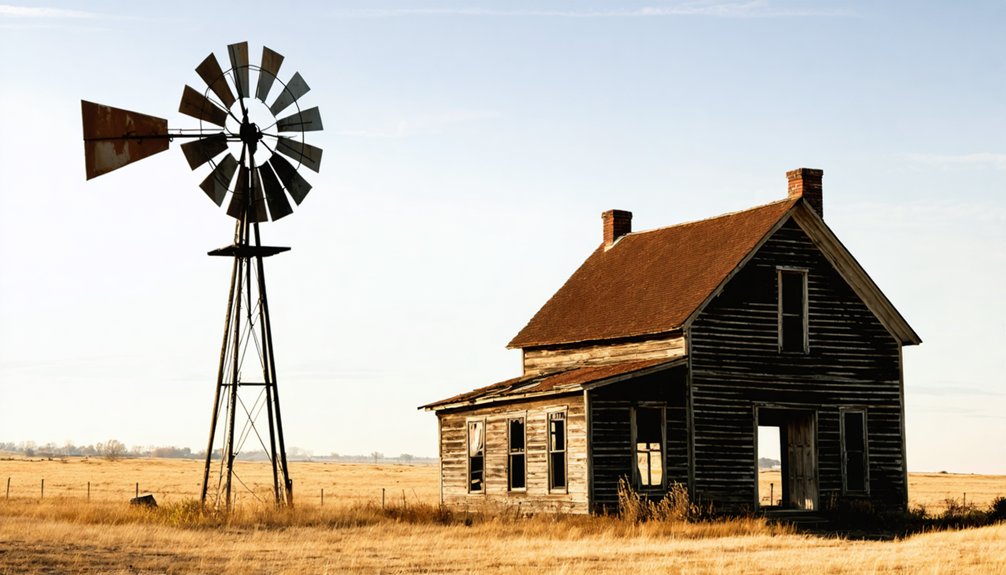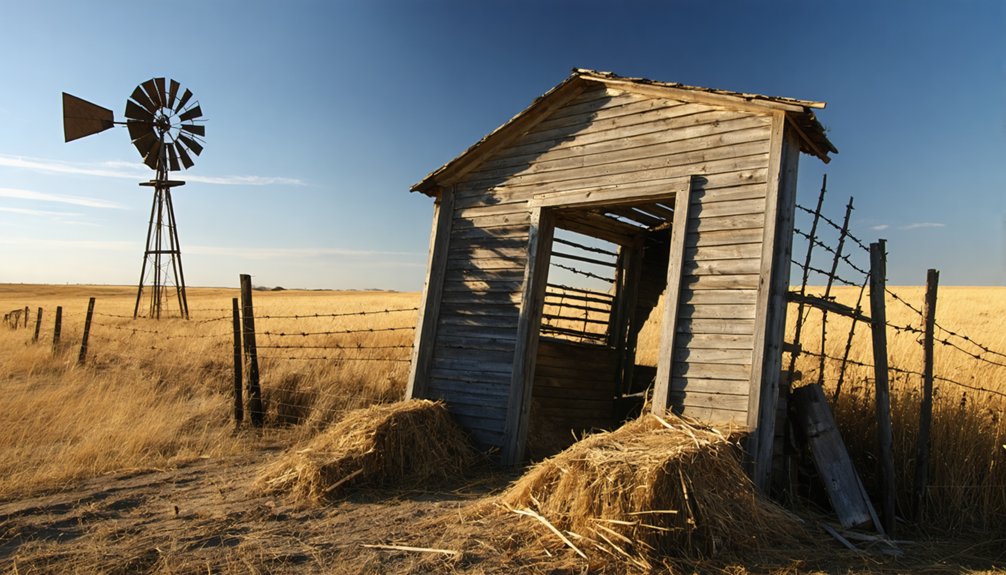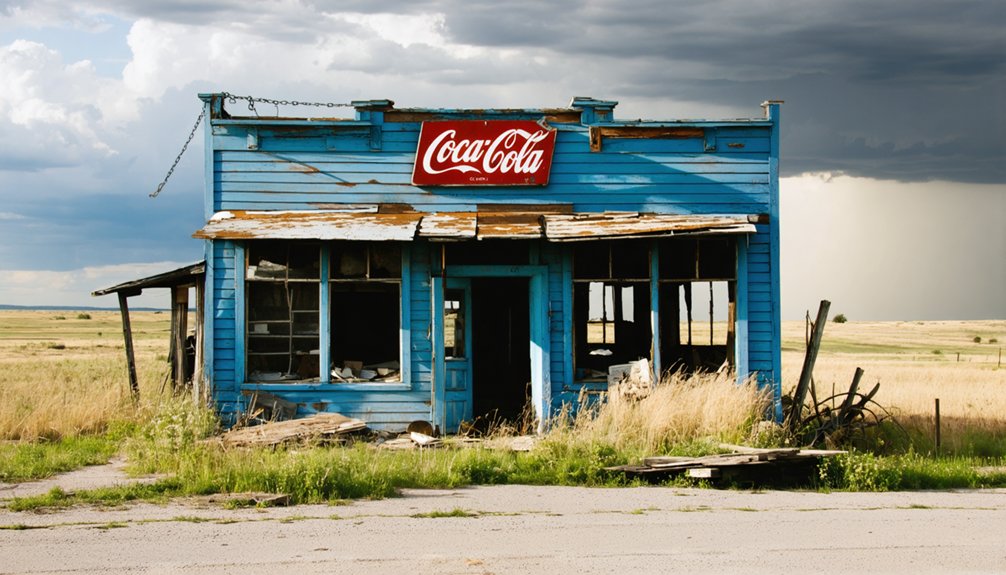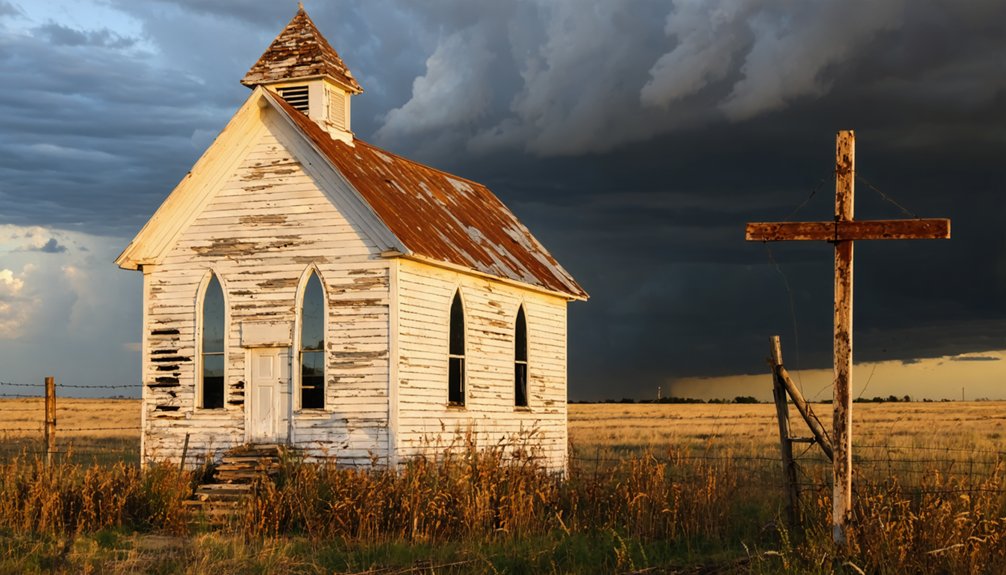You’ll find the ghost town of Ordway in Brown County, South Dakota, where it emerged as a promising frontier settlement in 1881. Named after territorial governor Nehemiah G. Ordway, the town flourished briefly as a railroad hub with hotels, stores, and grand political aspirations. When Bismarck became the territorial capital in 1883, Ordway’s dreams crumbled. By 1955, its post office closed, and today only open fields mark where this ambitious railroad town once stood. Its compelling story of rise and fall reveals much about Dakota Territory’s tumultuous frontier era.
Key Takeaways
- Ordway was established in 1881 by the Chicago and Northwestern Railroad but declined after losing its bid for territorial capital to Bismarck.
- The town’s population peaked at over 100 residents before dwindling to just 27 by 1900 due to economic setbacks.
- The post office closure in 1955 marked a definitive endpoint for the community, leading to its ghost town status.
- Today, Ordway consists only of open fields used for farming, with no remaining structures or markers of its existence.
- The Brown County Historical Society and Dacotah Prairie Museum preserve documentation of Ordway’s brief but significant history.
The Birth of a Railroad Town
While many frontier towns emerged gradually through organic settlement, Ordway sprang to life in the summer of 1881 as a deliberate creation of the Chicago and Northwestern Railroad in Dakota Territory. Named after territorial governor Nehemiah G. Ordway, this strategic rail terminus quickly transformed from a collection of tents and shanties into an organized townsite. The ambitious community had high hopes of becoming the territorial capital but ultimately lost that designation to Bismarck.
You’ll find the town’s founding was marked by the arrival of the first passenger train on August 1, 1881, establishing Ordway’s railroad significance as a crucial hub for mail, passengers, and telegraph communications.
The railroad’s presence shaped every aspect of early development, from the careful platting of streets to the construction of essential infrastructure like grain elevators and warehouses that would serve the surrounding farming community. The town rapidly grew to include a general store and hotels, along with a resident physician and church to serve its expanding population.
Territorial Dreams and Political Ambitions
As Dakota Territory debated its capital location in 1881, Ordway emerged as a promising contender due to its strategic position and namesake connection to Governor Nehemiah G.
The town’s founders banked on the governor’s political influence to secure their economic aspirations, even attracting plans for a prestigious Methodist university.
But you’ll find that political rivalry soon overshadowed these dreams.
President Hayes appointed Ordway as territorial governor in 1880, raising local hopes for favorable treatment.
Governor Ordway’s controversial decision to move the territorial capital to Bismarck in 1883 sparked fierce opposition from southern interests.
Historical records show this location needed proper disambiguation pages to distinguish it from other Ordway settlements.
Amid accusations of corruption and favoritism, Ordway’s administration crumbled, and he was eventually removed from office.
The town’s hopes were dashed – the university relocated to Mitchell, the capital dream died, and Ordway’s prominence faded as quickly as it had risen.
Early Business and Community Life
During the summer of 1881, Ordway sprang to life at the Chicago & Northwestern Railroad’s terminus, quickly establishing itself as a vibrant farming center.
You’d find remarkable business diversification in this ambitious settlement, from Richard Garland’s general store to two bustling hotels, grain elevators, and a lumberyard serving the agricultural community.
The town’s community resilience showed in its all-encompassing infrastructure. You could visit the local physician, seek legal counsel, or get your equipment repaired at the blacksmith shop.
The Methodist Church’s vision of building a university highlighted the town’s cultural aspirations. While the railroad’s extension to Columbia in 1883 eventually led to Ordway’s decline, these early years showcased a determined prairie town working to become a regional hub. Just as in other documented towns like Dewey and Spokane, physical remnants of buildings serve as historical markers of its once-thriving existence.
Like many railroad towns, Ordway was strategically placed seven miles apart from neighboring settlements to accommodate steam locomotive service needs.
Methodist University Plans and Promise
You’ll find that Ordway’s most ambitious early venture was a planned Methodist university, which the church had selected due to the town’s promising position at the end of the Chicago Northwestern Railroad line.
The Methodist Church’s investment sparked genuine optimism about Ordway’s future, with construction beginning in the early 1880s as part of their broader mission to establish educational institutions in Dakota Territory. Like many frontier settlements, Ordway residents viewed their town with infinite future potential. Founded in summer of 1881, the town seemed perfectly positioned to become a major educational center.
When Bismarck claimed the territorial capital in 1883 and the railroad extended beyond Ordway to Columbia, the Methodist Church abandoned their plans and later established what would become Dakota Wesleyan University in Mitchell instead.
Methodist Investment Brings Hope
A beacon of hope emerged for Ordway when Methodist University announced its ambitious $22 million investment in a new School of Health Sciences facility.
This transformative Methodist investment, secured through multiple funding sources including state appropriations and revenue bonds, promises to breathe new life into the region through community revitalization efforts. The project was funded through Senate Bill 40 and various other sources. Like the Founders Circle members of SAE who demonstrate transformative support, this investment shows dedication to education and community growth.
- You’ll witness the creation of a 45,000-square-foot hub for healthcare education, training tomorrow’s medical professionals right in South Dakota.
- You’ll see new jobs emerge during both construction and operational phases, boosting local economic growth.
- You’ll benefit from increased healthcare access as graduates stay to serve in regional medical facilities.
The three-story structure, set to open in August 2023, represents more than just a building – it’s your gateway to a thriving future in Ordway.
Educational Vision Gone Wrong
The modern Methodist investment stands in stark contrast to Ordway’s original Methodist university vision of the 1880s.
You’ll find that this ambitious educational vision was deeply intertwined with the town’s hopes of becoming a territorial powerhouse. The Methodist Church’s plans included not just a university, but a complete transformation of Ordway into a thriving educational hub.
Yet these educational aspirations crumbled when several critical factors aligned against the town. The railroad’s extension to Columbia in 1883 stripped Ordway of its transportation advantage, while the territorial capital’s placement in Bismarck dealt another blow.
Despite the community’s resilience, the Methodist university committee’s 1885 decision to build in Mitchell instead marked the beginning of Ordway’s decline from bustling frontier town to ghost town.
Lost Dreams of Growth
Dreams of academic prestige drove Ordway’s ambitious bid for a Methodist university in 1883, when the town stood at its economic peak as the terminus of the Chicago Northwestern Railroad line.
The bustling community’s economic aspirations seemed within reach, with its thriving businesses and strong community connections positioning it as an ideal candidate for both the territorial capital and a prestigious Methodist institution.
You can still feel the weight of those lost opportunities in Ordway’s story:
- The town’s strategic rail terminus advantage vanished when tracks extended to Columbia in 1883.
- Mitchell’s selection for Dakota University (now Dakota Wesleyan) crushed educational dreams.
- Bismarck’s designation as territorial capital delivered the final blow to Ordway’s metropolitan aspirations.
These setbacks triggered a decline that would eventually transform this once-promising hub into a ghost town.
Pivotal Events Leading to Decline
Once thriving as a promising frontier settlement, Ordway’s decline can be traced to three pivotal events in the 1880s.
First, the Chicago and Northwestern Railroad‘s extension to Columbia in 1883 stripped Ordway of its position as the line’s terminus, devastating its economic advantage.
Second, Bismarck’s selection as the territorial capital crushed the community’s aspirations for political prominence and related economic growth.
Finally, the Methodist Church’s decision to establish their university in Mitchell instead of Ordway eliminated the town’s chances of becoming an educational center.
You can see how these consecutive blows fundamentally altered Ordway’s trajectory, transforming it from a bustling frontier town with grand dreams into a diminishing settlement.
The Exodus and Abandonment

Following these devastating setbacks, Ordway experienced a swift and relentless exodus that would strip away its population and liveliness. By 1900, you’d have found just 27 residents clinging to what remained of their once-bustling railroad town.
The economic migration intensified as essential services vanished, with the post office’s closure in 1955 marking a point of no return in the community’s disintegration.
- Family homes stood empty as residents sought opportunities in more prosperous towns
- Local businesses shuttered their doors one by one, leaving gaps in the town’s commercial fabric
- The Methodist university’s departure to Mitchell shattered dreams of educational prominence
What you’ll find today are mere remnants of Ordway’s brief glory, silent testimony to the harsh realities of frontier boom-and-bust cycles.
Legacy in Dakota Territory History
Though Ordway’s time as a thriving settlement proved brief, its historical significance in Dakota Territory can’t be understated. Named after Governor Nehemiah G. Ordway, the town emerged as a symbol of territorial political legacy during the 1880s, even vying for territorial capital status before Bismarck’s selection in 1883.
You’ll find Ordway’s story interwoven with the broader narrative of Dakota Territory’s development, marked by economic challenges that typified the era.
When the Chicago Northwestern Railroad chose Ordway as its terminus in 1881, the town flourished with businesses, grain elevators, and cultural aspirations, including plans for a Methodist University.
Yet the railroad’s extension beyond Ordway in 1883, coupled with drought and falling wheat prices, transformed this once-promising hub into a reflection of the territory’s volatile settlement patterns.
What Remains Today

Today you’ll find nothing but open fields where Ordway once stood, with no remaining structures or markers to indicate the former railroad town‘s existence.
The site, accessible via rural roads near Highway 281, contains at most some deteriorated foundations hidden beneath agricultural land and prairie grass.
While the town’s story lives on in museum exhibits and historical archives, there are no active preservation efforts or tourist facilities at the location itself.
Physical Location Today
The once-bustling site of Ordway, South Dakota has transformed into a quiet agricultural landscape, with fields and pastures stretching across what was previously a promising township.
Today’s land use primarily centers around farming operations, with Aberdeen’s water treatment facility standing as the only significant modern development nearby.
If you’re searching for remnants of the original town, you’ll find that time and nature have reclaimed most traces of Ordway’s existence.
The area’s transformation reflects the harsh realities of frontier town development:
- The original buildings have crumbled or vanished entirely
- Farm fields now cover the former streets and building sites
- No visible markers remain to indicate the town’s historical significance
Nature and agricultural practices have fundamentally erased the physical footprint of this once-ambitious settlement.
Visible Historical Features
Visible remnants of Ordway’s past are remarkably scarce, with only subtle clues in the landscape hinting at the town’s former existence.
You’ll find the area has largely returned to agricultural use, with former building sites now absorbed into farmland. While historical markers are limited, you can still discover traces of the town’s cultural significance through the Aberdeen water treatment facility nearby.
The absence of original structures tells its own story of decline, from a hopeful railroad terminus to an abandoned dream.
If you’re exploring the site, you’ll need to rely on historical documentation and archival records to picture the once-bustling community that housed a hotel, blacksmith, and general store.
The land’s transformation reflects the harsh realities of frontier town development in South Dakota’s territorial period.
Access and Preservation Status
Since abandonment in the early 1900s, Ordway’s physical remnants have virtually disappeared from South Dakota’s landscape, leaving only open farmland where a bustling frontier town once stood.
While ghost town tourism opportunities are limited due to the absence of structures, you’ll find the site accessible via rural roads.
The Brown County Historical Society and Dacotah Prairie Museum in Aberdeen maintain historical documentation of Ordway’s past, preserving its legacy through:
- Archived photographs and written records of the town’s brief but significant railroad history
- Maps showing the original town layout and Chicago Northwestern Railroad connection
- Oral histories from descendants of early settlers who witnessed Ordway’s decline
No formal preservation efforts exist at the site itself, as natural elements and time have erased most physical traces of this once-promising settlement.
Lessons From a Vanished Settlement

Looking back at Ordway’s rise and fall reveals crucial insights for modern community development.
Examining past community failures and successes provides essential wisdom for building resilient, sustainable towns today.
You’ll find that over-reliance on single economic drivers – in this case, the railroad – can spell disaster for a town’s survival. Ordway’s story teaches important lessons about community resilience and the critical need for economic diversification.
When the railroad bypassed Ordway in 1883, the town hadn’t developed enough alternative economic foundations to sustain itself.
The loss of both the territorial capital bid and the Methodist university plans dealt additional blows to its future.
Today, you can learn from Ordway’s experience that successful towns must adapt to changing conditions, cultivate multiple revenue streams, and build strong foundations beyond initial infrastructure advantages to guarantee long-term survival.
Frequently Asked Questions
Are There Any Surviving Photographs of Ordway During Its Peak Years?
You’ll find limited historical documentation and visual archives of Ordway’s peak years, though some photos exist through Brown County Historical Society and local photographers Mike McCafferty and Mike Wiese’s collections.
What Happened to the Original Residents After Leaving Ordway?
Scattered like seeds in the wind, you’ll find former residents moved to nearby railroad towns like Aberdeen and Columbia, while others turned to farming or sought opportunities in growing cities like Mitchell and Bismarck.
Did Any Notable Historical Figures Visit Ordway Before Its Decline?
You won’t find records of famous visitors to this frontier town. Despite its historical significance as a railroad terminus, no notable figures are documented making stops during its brief heyday.
Were There Any Native American Settlements in the Ordway Area?
Like wind-swept echoes across the prairie, you’ll find evidence of Dakota settlements through teepee rings near Ordway. The area, known as *Imniżaska Otuŋwe*, was traditionally Dakota land before pioneer arrival.
What Natural Disasters or Weather Events Affected Ordway’s Early Development?
You’d have faced harsh Dakota Territory winters, drought conditions hampering early farming, and severe storms disrupting settlement. While challenging, these weather events were typical hardships rather than unique catastrophes affecting development.
References
- https://www.youtube.com/watch?v=Glucs_Rq8Xs
- https://aberdeenmag.com/2019/01/the-ghost-towns-of-brown-county/
- https://www.sdpb.org/arts-and-culture/2018-10-11/catching-up-with-stephanie-risslers-vanished-south-dakota-production
- https://bchsofsd.com/town/ordway/
- https://en.wikipedia.org/wiki/List_of_ghost_towns_in_South_Dakota
- https://www.sdpb.org/rural-life-and-history/The-Vanished-South-Dakota-town-of-Ordway
- https://www.youtube.com/watch?v=yVBa-9hhTBk
- https://history.sd.gov/preservation/docs/SDRailroad.pdf
- https://dacotahprairiemuseum.org/wp-content/uploads/2024/05/Living-Legacies-Railroad-Stations-of-Brown-County-SD-2002a.pdf
- https://www.sdhspress.com/journal/south-dakota-history-14-2/dakota-images-nehemiah-g-ordway/vol-14-no-2-dakota-images-nehemiah-g-ordway.pdf



